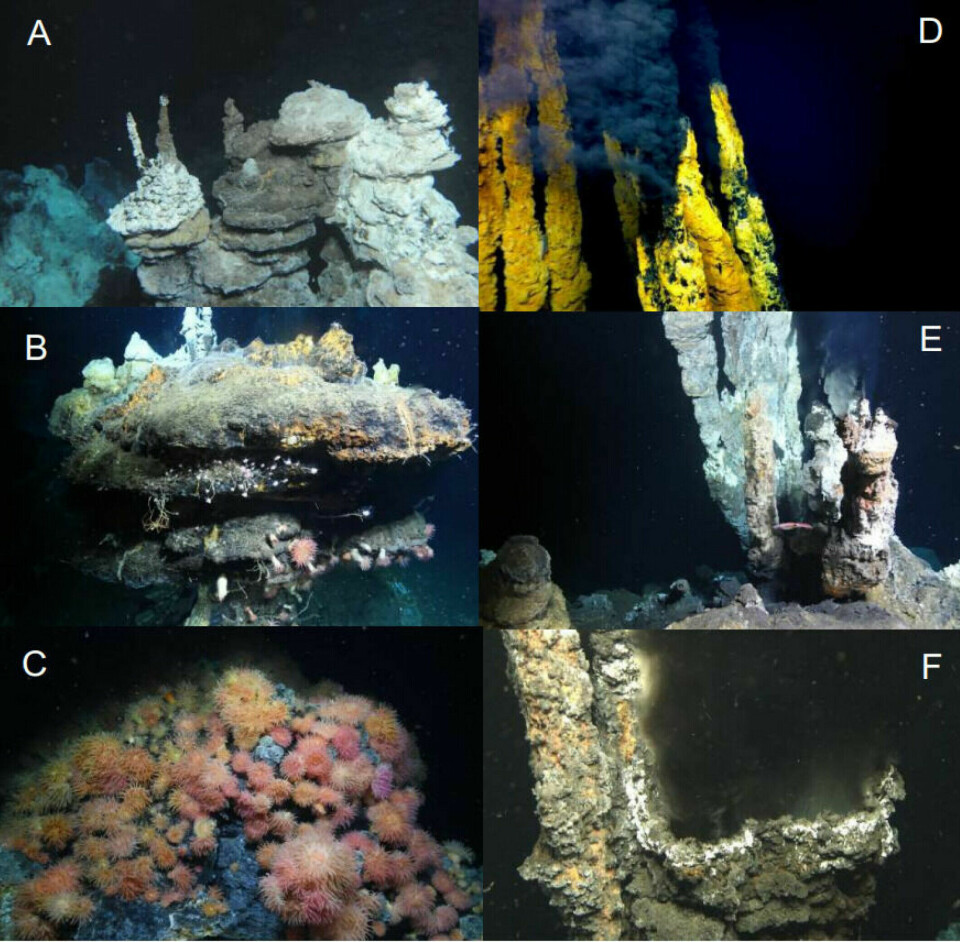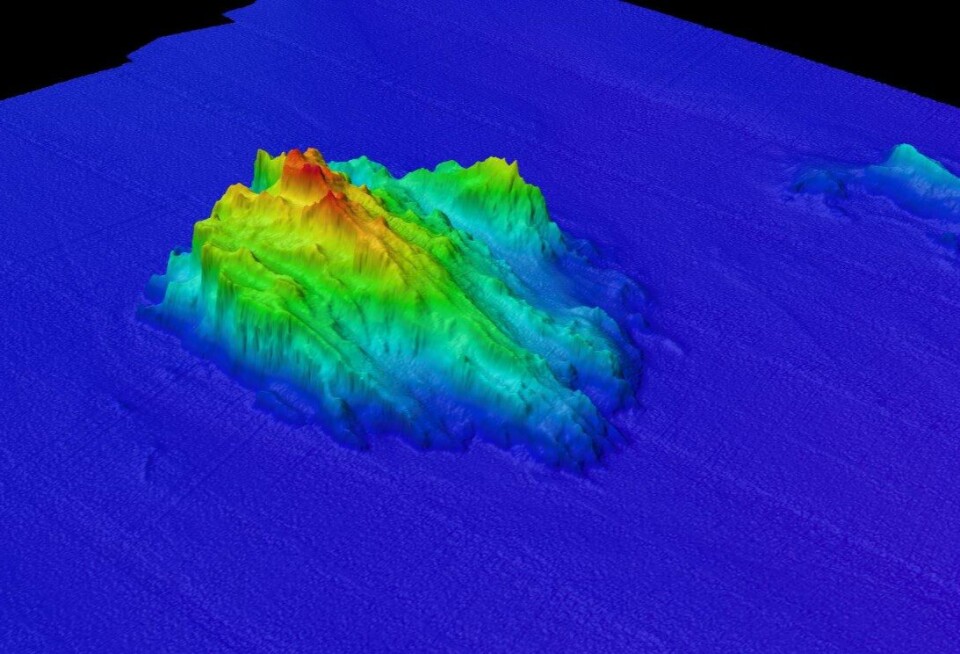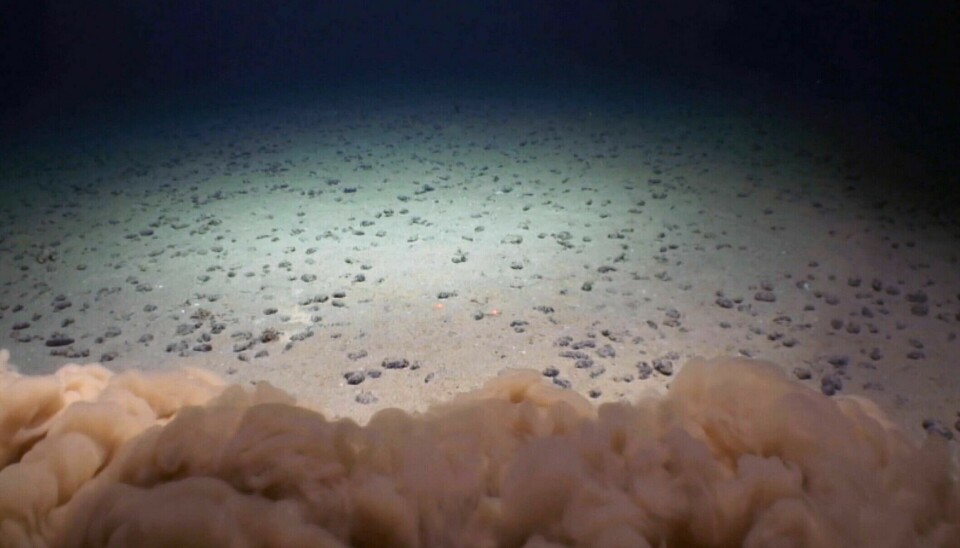
Researchers fear that the hunt for gold in the deep sea will suffocate sponges
Gold, silver, copper, and cobalt tempt politicians to open the deep sea for extraction. But we know too little about life down there, researchers at the University of Bergen say.
Norway is considering opening up a large area of the deep sea to exploration and possible mineral extraction. The valuable minerals are located in extinct volcanic fields where hot water has been drawn down into the ocean floor crust and enriched with metals.
In areas like this, which can be several hundred metres deep and wide, there is likely copper, cobalt, silver, and gold.
Along slopes and on underwater mountains, there are also crusts that contain metals used in modern technology.
If these fields are to be dug up or scraped off, it will affect the wildlife on the seabed. But how?
Critical to opening
Several experts have pointed out that we know too little about the environmental consequences, in reaction to the Norwegian government's impact assessment.
- The Institute of Marine Research wrote that there is documented "serious lack of knowledge about natural conditions and bottom currents in the study area".
- The Centre for Deep Sea Research at the University of Bergen wrote that the factual basis is good enough to start an exploration phase, but then a clear regulatory framework must be established to protect the environment. Much more knowledge is needed before mineral extraction can be permitted, the group believe.
- The Norwegian Environment Agency was strongly critical and wrote that the impact assessment does not provide a basis for allowing mineral extraction at sea. Among other things, the agency believes it is necessary to determine which areas should be protected first.
Most viewed
Dig or scrape out
There may be rich sponge grounds on or near some of the metal-containing crusts. Sponges are primitive animals that do not have real tissues or organs, according to Wikipedia. Fossil findings suggest that sponges were among the first animals on Earth.
In hydrothermal vents where mineral-rich water flows out of mountain formations on the seabed called chimneys, there is animal life that only lives in these small areas. There are recently extinct hydrothermal areas that are appropriate to dig up. These are often close to active hydrothermal fields, according to the Storting White paper on the proposal (link in Norwegian). There is thus a risk that active fields may be affected.
It is still poorly understood what kind of wildlife exists on inactive fields and whether there are unique communities there.
“Most people in the scientific community say that we don't know enough about inactive fields to be able to make a recommendation,” Pedro Ribeiro says.
He is a researcher and deputy head of the Centre for Deep Sea Research at the University of Bergen (UiB).
What could affect this environment?
The direct impact will be that life on the seabed is destroyed where the minerals are to be dug up or scraped out, Ribeiro says. Animal habitat will be removed from the fields that will be mined.
However, most of the seabed will not be directly affected, says Steinar Løve Ellefmo. He is a professor at the Department of Geosciences and Petroleum at the Norwegian University of Science and Technology (NTNU) and studies mineral extraction from the deep sea.
An extinct hydrothermal vent is only a few hundred metres in extent in a vast landscape.
“These aren’t found everywhere. That means you don’t need to carpet the seabed with production equipment. The vast majority of areas will be left alone, at least from direct stone crushing,” Ellefmo says.

How harmful are sediment plumes?
When machines disturb and dig up the seabed, particles of sand, mud, or crushed rock particles from the activity will be stirred up.
It will billow as a cloud of dust around the machines.
Sponges and other nearby organisms that filter water can be covered by the sediment or suffocated by it, Ribeiro explains.
“We know little about how a sediment plume created by mining can spread and which areas it can affect. No studies have been done with real cases,” he says.
There have also been no studies with data from the Norwegian area that could provide a clue of what might happen, says Ribeiro.
Akvaplan-niva, a non-profit research institute, has assessed the environmental consequences. The group has looked at existing research and believes that the particle cloud could cause damage as far as one kilometre from any mining area.
These sediment plumes could pose a medium risk for seamounts, because life there can take quite a long time to return. For old, collapsed chimneys, the consequences are assessed as small, if the wildlife there does not differ from what is found elsewhere in the area.

Can reduce the problem
Egil Tjåland says that there has been a lot of attention paid to the consequences of sediment plumes. He is an associate professor at the Department of Geosciences and Petroleum at NTNU and general secretary of the Norwegian Forum for Marine Minerals, an interest organization for the extraction of seabed minerals.
“It turns out that the fear that there would be large sediment plumes is greatly exaggerated,” Tjåland believes.
He described a study published in Science Advances last year. It showed that most of the sediments did not swirl higher than two metres. This study was conducted in connection with the extraction of polymetallic nodules in the Pacific Ocean.
However, the study was undertaken in a different environment and with a different type of mining than what would happen in Norway. Nevertheless, Tjåland believes the findings are partly transferable to the Norwegian seabed.

It is possible to reduce the problem with sediment plumes, Tjåland points out.
“Most people who want to enter the market know that this is a potential showstopper. They will then have to reduce how much they release. It’s possible to design closed systems,” he says.
Sediment will also spread when water that has been carried up into the ship along with minerals is released again. Water containing sludge can be discharged high up or far down in the water column. This will have different effects depending on where it is released.
It is also possible to limit this.
Toxic substances in the water
Another danger with the sediment that would be swirled up is that the plumes may contain metals that are toxic to organisms in the area.
“We don't know the effect of releasing these metals when they are dissolved in the water column. We don't know the minimum dose that can cause mortality or damage to the animals,”Ribeiro says.
He mentions that UiB is involved in a research project to check how organisms in the deep sea sediment react to the deposition of crushed minerals. They will run a similar experiment on an area of sponge ground to see how much the sponges can tolerate.
According to the Akvaplan-niva report, international studies suggest that metals are released at up to 300 times harmful levels within 100 meters of where extraction occurs.
The consequences of this have been assessed as small to medium because it is only a small area that is affected, but more knowledge is needed, the researchers write.
Noise, light pollution, and vibrations are also possible disturbances. In the Akvaplan-niva report, the consequences of this for fish, marine mammals, and seabirds were assessed as small.

Moving too fast
Pedro Ribeiro thinks it is too early to assess how much mining-related disturbance deep sea life can withstand without it causing serious and irreversible damage to biodiversity.
There’s not much food at the bottom of the ocean, and conditions are harsh. Sometimes these deep sea creatures can be separated by long distances. But some seamounts and cliffs are dense with sponges, anemones, and other animals.
“Different areas are connected via larval dispersal. One population may be dependent on larvae emerging from another,” he says.
The young stages of many bottom-dwelling animals can travel with currents to establish populations on another seamount or on hydrothermal fields.
The connections between life on different seamounts is unknown. We need to know more about this to be able to assess how to protect this life, Ribeiro believes.
He also thinks we know too little about the effects of toxic substances in the water and about sediment plumes.
“It's possible to do the studies necessary to get the right answers,” he says. “In my opinion, the process is going too fast.”
Do not know enough about the connections
Much of the deep sea is still unknown terrain. How much do we really know about what lies in the deep sea off Norway?
“The area that has been proposed to be opened for exploration activities is enormous. If you think about how much area we have mapped in detail, filmed, and sampled, it's a very small area in comparison,” Mari Heggernes Eilertsen says.
Eilertsen studies the biology of the deep sea at the Centre for Deep Sea Research at UiB.
“We know quite a bit about the types of nature found in the area,” she says.
The researchers know there are different species that selectively live on soft bottoms, on seamounts, and at different depths.
“Many species in the deep sea are new to science, and we have described several new species from the area in question. But there is still a lot to be done. When you go up a level and talk about the ecology and function of the different communities there, we are really at the very early stages,” she says.
Community-level ecology is all about understanding how nutrients are used and transferred between different ecosystems and how the organisms spread and are connected genetically.
“We know very little about that. There are huge gaps in what we know,” she says. “These are things we need to understand better in order to say whether an industrial activity will only have a local effect or whether there will be ripple effects in the surrounding areas."
———
Translated by Nancy Bazilchuk
Read the Norwegian version of this article at forskning.no






































